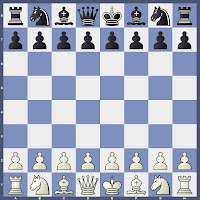Forcing moves....unforced errors!
".....there are a number of general problem-solving techniques, which mathematicians use all the time but seldom articulate." - George Polya
What that great mathematician said is true not only for maths....but in chess too! By problem solving, it should not be wrongly construed that it is a tactical exercise....even solving a positional problem is problem solving....tactics are mere device which executes a sequence of moves which results out of positional considerations...preponderance.
Polya further devised a way to approach the mathematical problem, which he called heuristic strategy. He divided the heuristic strategy into four parts:
What that great mathematician said is true not only for maths....but in chess too! By problem solving, it should not be wrongly construed that it is a tactical exercise....even solving a positional problem is problem solving....tactics are mere device which executes a sequence of moves which results out of positional considerations...preponderance.
Polya further devised a way to approach the mathematical problem, which he called heuristic strategy. He divided the heuristic strategy into four parts:
- understanding the problem
- trying to use experience from related problems to plan an attack
- carry out the attack. And finally....
- ask yourself whether you really believe the answer you've got
Mathematics is a vast space, unlike chess....Chess in not infinite.....yet
....what Polya listed applies in Chess too!
Many a time, even the great masters fail to articulate the above and land in trouble!
Chess failures....on most occasions than not.... are the result of non adherence to fundamental principles....despite.....!
Jan Hein Donner - Jan Smejkal, Wijk aan Zee - 1975
I was primarily interested in a bizarre happening during 35 to 55 moves in this game....
.....but lot's happened before that!
Probably this line is mainly to avoid the main lines and theoretical debates. But definitely playable as one off try depending on the tournament situation.
12.Bd4
This line first appeared in the game between Stahlberg vs Szabo, Kemeri - 1939! Stahlberg continued 12.Na4!? and for whatever reason it has never been repeated.....probably because of the two 'ugly' looking doubled pawns!! In any case, it is not a pleasurable position....the game continued... 12.....de3; 13.Qd8 Kd8; 14.fe3 Nd7; 15.Nf3 e6; 16.Ke2 Ke7; 17.Rhc1 Rb8; 18.Rc7 Kd8; 19.Rc2 Ne5; 20.Nc5 Nf3; 21.Bf3 a6; 22.Rd1? White should have got rid off one of his double pawns to smother Black's light squared Bishop 22.......Ke8; 23.Na4 Bd7; 24.Nb6 Bb5?
This move is simply bad as it the starting point of spoiling a good position. Szabo managed to allow White pieces to enter into his territory, decisively.
A simple 24.....Bc6 would have maintained the equilibrium and if and once he manages to bring his Rook to the central files, he might even assume initiative!
12....Bd4; 13.Nge2 Bb6; 14.Nd5 OO; 15.OO Be6; 16.Nb6?
If it was Szabo's .....Bb5? in the previous game, it is this ill advised exchange in the current game, which ends up spoiling a good position. 16.Nec3! or even Nef4 would have maintained the equilibrium and probably yielded a slight pull as the game goes on, sheerly on White's control of more squares in the centre!
16.....Qb6; 17.Qd4 Na6; 18.Qb6 ab6; 19.b5 Nc5; 20.Nd4?
This one is inexplicable......especially from a player of Donner's class. A seriously bad move which disturbs the equilibrium badly. Of course, 20.Nc3 begs to be played with equal chances.
20.....Bc4; 21.Ra8 Ra8; 22.Rc1 Bd3; 23.e5
Generally, in chess, if a side is forced to push his pawn or forced to exchange, then it means that something has not gone well. Every pawn push, not only weakens the squares that it leaves behind, but also renders the pawn which advances forcibly, weak and vulnerable.
The pawns are used to provide cover and protected squares so as to enable one's pieces to manoeuvre and threaten opponents pieces and induce weakness in opponent's structure. Whilst they also prevent opponent pieces from infiltration.
But in this position, White has already allowed too much....
23....Ra4; 24.Nf3
The result of its faulty move to d4 square on move 20.
24.....Rb4; 25.Ne1 Bb5; 26.Rc2 g5; 27.Bf1 Bf1; 28.Kf1 Kg7; 29.f3 h5; 30.h3 Kg6; 31.g4 Rb3; 32.Rd2 h4; 33.Kf2 b5; 34.Ke2 b6; 35.Kf2 Kg7; 36.Ke2........
.............54......Kg7
......and for the next 18 moves, both sides moved their King's meaninglessly....and I haven't checked whether there occurred threefold repetition of photographic position!
Smejkal wanted to seal the move so that he can easily find the winning plan in the adjournment analysis!
Meanwhile, the winning plan is quite simple as you can observe from the reminder of the game!!
55.Kf2 f6; 56.ef6 Kf6; 57.Ke2 e6; 58.Kd1 Ke7; 59.Re2 Na4; 60.Kc1 Kf6; 61.Rf2 e5; 62.Re2 Nc5; 63.Kc2 e4!
64.fe4 Rh3; 65.Rf2 Ke7; 66.Rf5 Ne6; 67.Kd2 Rh2; 68.Kc3 h3; 69.Nd3
This Knight is moving after hibernating on the e1 square for 45 moves!!!
69.....Rg2; 70.Rf3 Nf4! 71.Nf4 gf4 0 - 1
A very unusual game!






.jpg)
.jpg)

Comments
Post a Comment